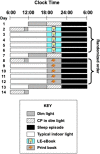Evening use of light-emitting eReaders negatively affects sleep, circadian timing, and next-morning alertness
- PMID: 25535358
- PMCID: PMC4313820
- DOI: 10.1073/pnas.1418490112
Evening use of light-emitting eReaders negatively affects sleep, circadian timing, and next-morning alertness
Abstract
In the past 50 y, there has been a decline in average sleep duration and quality, with adverse consequences on general health. A representative survey of 1,508 American adults recently revealed that 90% of Americans used some type of electronics at least a few nights per week within 1 h before bedtime. Mounting evidence from countries around the world shows the negative impact of such technology use on sleep. This negative impact on sleep may be due to the short-wavelength-enriched light emitted by these electronic devices, given that artificial-light exposure has been shown experimentally to produce alerting effects, suppress melatonin, and phase-shift the biological clock. A few reports have shown that these devices suppress melatonin levels, but little is known about the effects on circadian phase or the following sleep episode, exposing a substantial gap in our knowledge of how this increasingly popular technology affects sleep. Here we compare the biological effects of reading an electronic book on a light-emitting device (LE-eBook) with reading a printed book in the hours before bedtime. Participants reading an LE-eBook took longer to fall asleep and had reduced evening sleepiness, reduced melatonin secretion, later timing of their circadian clock, and reduced next-morning alertness than when reading a printed book. These results demonstrate that evening exposure to an LE-eBook phase-delays the circadian clock, acutely suppresses melatonin, and has important implications for understanding the impact of such technologies on sleep, performance, health, and safety.
Keywords: chronobiology; digital media; electronics; phase-shifting; sleep.
Conflict of interest statement
Conflict of interest statement: Dr. Czeisler has received consulting fees from or served as a paid member of scientific advisory boards for: Boston Celtics; Boston Red Sox; Citgo Inc.; Cleveland Browns; Merck; Novartis; Purdue Pharma LP; Quest Diagnostics, Inc.; Teva Pharmaceuticals Industries Ltd.; Valero Inc.; Vanda Pharmaceuticals, Inc. Dr. Czeisler currently owns an equity interest in Lifetrac, Inc.; Somnus Therapeutics, Inc.; Vanda Pharmaceuticals, Inc., and between October 2012 and October 2013, Apple, Inc. and Microsoft, Inc. Dr. Czeisler received royalties from McGraw Hill, Penguin Press/Houghton Mifflin Harcourt, and Philips Respironics, Inc. and has received grants and research support from Cephalon Inc., National Football League Charities, Philips Respironics, ResMed Foundation, San Francisco Bar Pilots and Sysco. Dr. Czeisler is the incumbent of an endowed professorship provided to Harvard University by Cephalon, Inc. and holds a number of process patents in the field of sleep/circadian rhythms (e.g., photic resetting of the human circadian pacemaker). Since 1985, Dr. Czeisler has also served as an expert witness on various legal cases related to sleep and/or circadian rhythms, including matters involving Bombardier, Inc.; Delta Airlines; FedEx; Greyhound; Michael Jackson's mother and children; Purdue Pharma, L.P.; United Parcel Service and the United States of America.
Figures




Comment in
-
A tablet that shifts the clock.Proc Natl Acad Sci U S A. 2015 Jan 27;112(4):946-7. doi: 10.1073/pnas.1423498112. Epub 2015 Jan 20. Proc Natl Acad Sci U S A. 2015. PMID: 25605912 Free PMC article. No abstract available.
-
Reply to Zeitzer: Good science, in or out of the laboratory, should prevail.Proc Natl Acad Sci U S A. 2015 Mar 31;112(13):E1514. doi: 10.1073/pnas.1501544112. Epub 2015 Mar 11. Proc Natl Acad Sci U S A. 2015. PMID: 25762077 Free PMC article. No abstract available.
-
Real life trumps laboratory in matters of public health.Proc Natl Acad Sci U S A. 2015 Mar 31;112(13):E1513. doi: 10.1073/pnas.1500717112. Epub 2015 Mar 11. Proc Natl Acad Sci U S A. 2015. PMID: 25762078 Free PMC article. No abstract available.
References
-
- Czeisler CA. Perspective: Casting light on sleep deficiency. Nature. 2013;497(7450):S13. - PubMed
-
- McIntyre IM, Norman TR, Burrows GD, Armstrong SM. Human melatonin suppression by light is intensity dependent. J Pineal Res. 1989;6(2):149–156. - PubMed
-
- Brainard GC, et al. Dose-response relationship between light irradiance and the suppression of plasma melatonin in human volunteers. Brain Res. 1988;454(1-2):212–218. - PubMed
Publication types
MeSH terms
Substances
Grants and funding
LinkOut - more resources
Full Text Sources
Other Literature Sources
Medical
Miscellaneous

